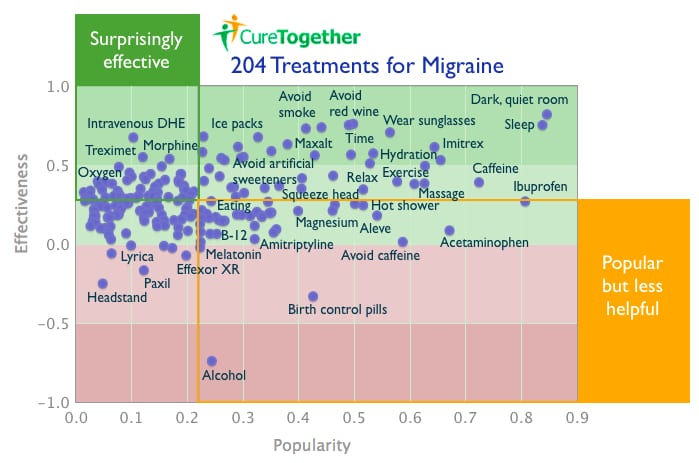
For the live-updated, fully-labelled, interactive version of this infographic, click here.
Eight of the top ten patient-reported treatments for Migraine are simple lifestyle changes, not drugs. CureTogether – a free resource owned by 23andMe that allows people to share information about their health and treatments – surveyed more than 6,000 people who self-identify as having Migraine. They reported that interventions such as sleeping in  a dark, quiet room, avoiding smoke and red wine, and using ice packs helped them feel better.
a dark, quiet room, avoiding smoke and red wine, and using ice packs helped them feel better.
Migraine can involve debilitating pain for many hours or days, sometimes interfering with work and day-to-day activities. Participants in the study said they found that prescription medications like Imitrex, Treximet, and DHE, as well as relaxation, hydration, caffeine, and exercise were among the most effective treatments. The survey also found that some common treatments such as alcohol, contraceptive pills, headstands, Paxil and Effexor XR actually made the symptoms of Migraine worse.
The Migraine Research Foundation estimates that over ten percent of the population, including children, suffers from Migraine, with a frequency ranging from once a month to every day. Nearly one in four US households has a Migraine sufferer in it. The condition can be extremely painful and is not well
1. Dark, quiet room
2. Sleep
3. Eliminate red wine
4. Passage of time
5. Eliminate MSG
6. Avoid smoke
7. Wear sunglasses
8. Intravenous DHE
9. Imitrex injection
10. Ice packs
understood, and finding accurate recommendations on treatments that work well can be challenging, so CureTogether asked people who experience Migraine to rate the effectiveness of 204 different patient-reported treatments.
Where did this data come from? This is the result of a four-year CureTogether study on Migraine, in which 6,259 people shared information about their symptoms and what treatments worked best for them. We’d like to thank those who participated. And just as they shared their experience with treatments, we’re freely and openly sharing the results of the Migraine study.
This is part of a regular series of CureTogether research findings. CureTogether’s research findings are different than
associations with illness, traits and drug response. But as we continue our work with the CureTogether community, 23andMe hopes to incorporate more of this kind of self-reported information into our own
![]()
23andMe customers can view their results in the Preliminary Research report on Migraines.
Not yet a customer? Visit our store!
research. CureTogether present its findings just as they are – patient-reported data – to stimulate discussion and generate new insights for further research.
Please tweet, blog, or pass this along to anyone who can benefit or is interested in Migraine. Thank you!